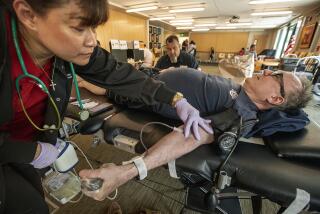Beginning of U.S. Epidemic : Drug Users--Not Gays--Called First AIDS Victims
- Share via
STANFORD — The first victims of the AIDS epidemic in the United States were intravenous drug users, and not male homosexuals as generally believed, a Harvard scientist told researchers here Thursday.
Although the devastating disease was first diagnosed in gays, “it was the druggies, not the gays, who started it,” said Dr. William A. Haseltine, an AIDS researcher at the Dana-Farber Cancer Institute at Harvard.
“The consequences are worrisome because many IV drug users are prostitutes,” he said, thus increasing the likelihood that AIDS has spread more extensively into the heterosexual population.
Stanford Symposium
Haseltine, a collaborator with National Cancer Institute scientists who first isolated and identified the AIDS virus, spoke at a symposium on genes and disease at the Stanford School of Medicine.
His comments came amid increasing concern that AIDS may be spreading beyond the known high-risk groups--homosexual and bisexual men, intravenous drug users, recent Haitian immigrants, hemophiliacs and recipients of blood transfusions.
Coincidentally, two studies published in today’s Journal of the American Medical Assn. provide the first evidence of heterosexual female-to-male transmission of the AIDS virus in the United States.
Dr. Robert R. Redfield and his colleagues at the Walter Reed Army Medical Center reported that 15 of 41 male and female AIDS patients had acquired the infection from heterosexual contact.
As of Monday, 142 of the 14,125 AIDS cases in the U.S. were thought to be caused by heterosexual exposure to the virus, according to the federal Centers for Disease Control. Less than 1% of heterosexuals are believed to be carrying the AIDS virus--compared to, say, 40% to 60% of homosexual men in San Francisco. It is not known how contagious AIDS is from heterosexual contact.
Numerous studies have documented male-to-female transmission, while female-to-male transmission has been reported in Africa and Haiti.
Many researchers speculate that AIDS was brought to this country from Africa by Americans who visited there. According to Haseltine, 90% of prostitutes in Africa who have been tested have been exposed to the virus.
Contact With Blood
In the second study, Dr. Stanley H. Weiss of the National Cancer Institute and his colleagues detailed two cases of “probable” transmission of the AIDS virus to health care workers as a result of accidental contact with the blood of AIDS patients.
One of the workers had needle-stick injuries. After developing swelling of her lymph glands and episodes of diarrhea, she was found to have antibodies to the virus. The AIDS virus was subsequently isolated from her asymptomatic long-term male sexual partner.
Weiss said this case was his strongest evidence for ‘probable’ occupational exposure and female-to-male transmission of the virus.
As of May, 371 cases of AIDS had been reported among health care workers; all but 31 were members of the high-risk groups for the disease.
In an editorial accompanying the articles, Dr. Dean F. Echenberg of the San Francisco Department of Public Health cautioned, “Since AIDS has an incubation period of up to five years, asymptomatic infected heterosexuals may be unknowingly spreading (the virus) to their sexual contacts.”
Generations of Infection
He added, “If we do nothing, we can expect multiple generations of infection to extend unchecked into the heterosexual community.” Echenberg called for health officials to obtain from all AIDS patients their heterosexual contacts and for those contacts to receive blood tests, so that those among them who had been infected with the virus could be individually counseled.
The first report of AIDS in the medical literature was published in June, 1981, by researchers at UCLA Medical School. It involved four male homosexual patients who suffered from an unusual type of pneumonia called pneumosystis pneumonia, which since has been incorporated into the definition of an AIDS case.
But two years earlier, in 1979, according to Haseltine, intravenous drug users in New York City were dying of the same disease, although doctors there had attributed it to “walking pneumonia.” Walking pneumonia is a well-known ailment whose medical name is lymphoid interspitial pneumonitis.
The scientific basis for Haseltine’s assertion rests on blood samples obtained from intravenous drug users in 1979, which had been tested for the presence of antibodies to the AIDS virus.
High Infection Rate
Haseltine said that 30% of the samples tested positive--an indication that one-third of New York City drug abusers had been infected by the AIDS virus by 1979. Today, he said 60% to 80% of New York drug abusers have antibodies to the virus.
According to Haseltine, one in three New York prostitutes has been exposed to the AIDS virus.
His interpretation of the 1979 blood studies differs somewhat from that of Dr. Don Desjarllis, assistant deputy director for substance abuse and research for the state of New York.
In a telephone interview, Desjarllis said that while it is “clear there was a substantial spread in New York City two years before AIDS was recognized in any group,” he believes the spread was from gays to drug users rather than vice versa.
It probably began with gays because they travel more internationally than do drug users, he said.
Harry Nelson reported from Stanford and Robert Steinbrook from Los Angeles.






